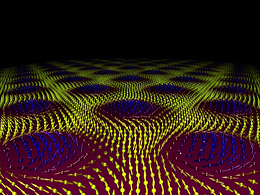Saving data in vortex structures:
New physical phenomenon could drastically reduce energy consumption by computers

Three years ago Professor Christian Pfleiderer and his team from the physics department at the TUM discovered an entirely new magnetic structure in a silicon manganese crystal – a grid of magnetic eddies. Together with the team of Professor Achim Rosch from the University of Cologne, he studied the properties of these eddies, so-called skyrmions, named after the British physicist Tony Skyrme, who predicted their existence 50 years ago. They were expecting results in the field of so-called spintronics, nano-electric components that utilize not only the electric charge of electrons for processing information, but also their magnetic momentum, known as spin.
While Peter Grünberg and Albert Fert received the Nobel Prize in 2007 for work on significantly faster data readout, research today concentrates on the question of how magnetic information can be written directly to materials via electric current. However, the extremely strong electric currents required produce side effects, which are practically untamable, even in nano-structures. Since skyrmions can be moved with 100,000 times less current, interest has been aroused in both the scientific community and in industry.
Although magnetic eddies were discovered in silicon manganese it was clear that it would not remain the only material capable of generating skyrmions. This has turned out to be true. Meanwhile, Japanese researchers have proven that individual eddies can be generated, and a group of physicists from the Research Center Jülich, as well as the Universities of Hamburg and Kiel, provided evidence that magnetic eddies can be generated on surfaces. They managed to build a data bit out of only 15 atoms. By way of comparison, a magnetic bit on a common hard drive requires about one million atoms. Yet, writing, updating and reading out information remained a problem. So far, Professor Pfleiderer’s team has resorted to neutron radiation from the neighboring research reactor FRM II at the TU München to study the materials. “We can just take the crystals generated in our laboratory at the physics department, walk over there and use the neutrons to measure the magnetic structure, its dynamics and many other properties,” said Christian Pfleiderer.
Using neutron radiation, the scientists were able to prove that even the tiniest of currents are sufficient to move the magnetic eddies. Now the physicists have developed a method by which skyrmions can be moved and measured in a purely electronic manner. “When the electric eddies move in a material, they generate an electric field”, said Christian Pfleiderer. “And that is something we can measure directly with electronic equipment available in our laboratory.”
At present a current is used in the read/write head of a hard drive to generate a magnetic field in order to magnetize a spot on the hard drive and thus write a data bit. Skyrmions, in contrast, can be moved directly – and that with very small currents. “This should make saving and processing data much more compact and energy-efficient,” said Christian Pfleiderer.
However, the measurement of this phenomenon still depends on very low temperatures. The European Research Council is currently funding a project with the aim of developing new materials that will permit the use of skyrmions at room temperature. But there is a lot of research work yet to be done before the first electronic components based on this technology reach the market.
This research was sponsored through grants from the Deutsche Forschungsgemeinschaft (DFG, SFB 608, TRR 80, FOR 960), the Deutsche Telekom Stiftung, the European Research Council (ERC Advanced Grant) as well as the TUM Graduate School and the Bonn Cologne Graduate School.
Original publication:
Emergent electrodynamics of skyrmions in a chiral magnet
T. Schulz, R. Ritz, A. Bauer, M. Halder, M. Wagner, C. Franz, C. Pfleiderer, K. Everschor, M. Garst and A. Rosch, Nature Physics, Online, 19 Februar 2012 – DOI: 10.1038/nphys2231
Multimedia:
http://mediatum2.ub.tum.de/node?cfold=1006342&dir=1006342&id=1006342
- Animation: An electron (black sphere) is flying over a grid of magnetic eddies. The forces involved make it possible to control the magnetic structure with a very small current. (Copyright: Prof. A. Rosch / University of Cologne)
- 101217_Pfleiderer.jpg: Prof. Dr. Christian Pfleiderer is preparing a sample for measurement at the neutron reactor FRM II. (Copyright: W. Schuermann / TU München)
- Skyrmion_elektron: The overall course of the electron as it passes through a magnetic eddy. (Copyright: TU München)
- 101216_magnetische Wirbel: Magnetic eddies in silicon manganese form a regular grid.
Contact:
Prof. Christian Pfleiderer
Department of Physics
Technische Universität München
James-Franck-Str. 1, 85748 Garching, Germany
Tel.: +49 89 289 14720
christian.pfleiderer@frm2.tum.de
www.e21.ph.tum.de/